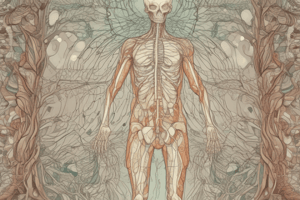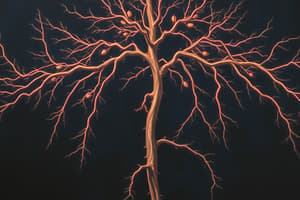Podcast
Questions and Answers
What role does the Autonomous Nervous System (ANS) play in the body?
What role does the Autonomous Nervous System (ANS) play in the body?
- Promotes sensory perception and interpretation
- Regulates the internal environment and homeostasis (correct)
- Generates conscious thoughts and actions
- Regulates voluntary muscle movements
What happens during the activation of the parasympathetic nervous system?
What happens during the activation of the parasympathetic nervous system?
- Increases alertness and metabolic rate
- Prepares the body for emergency responses
- Stimulates the release of stress hormones
- Promotes digestion and reduces metabolic rate (correct)
Which of the following statements is true about the sympathetic nervous system?
Which of the following statements is true about the sympathetic nervous system?
- Decreases heart rate and metabolic function
- Increases digestive activity and promotes rest
- Kicks in during resting conditions
- Prepares the body for exertion or emergency (correct)
Which control mechanism does the ANS primarily operate under?
Which control mechanism does the ANS primarily operate under?
Which of the following systems is NOT a part of the ANS?
Which of the following systems is NOT a part of the ANS?
How does the ANS contribute to maintaining homeostasis?
How does the ANS contribute to maintaining homeostasis?
During times of stress, which nervous system is primarily activated?
During times of stress, which nervous system is primarily activated?
In which scenario is the sympathetic nervous system likely to be activated?
In which scenario is the sympathetic nervous system likely to be activated?
What occurs to some neurotransmitters after they are released into the synaptic cleft?
What occurs to some neurotransmitters after they are released into the synaptic cleft?
What is the primary advantage of synapses in nerve impulse transmission?
What is the primary advantage of synapses in nerve impulse transmission?
What type of synapse is associated with the fastest possible neural responses?
What type of synapse is associated with the fastest possible neural responses?
Which of the following correctly describes the role of synaptic vesicles?
Which of the following correctly describes the role of synaptic vesicles?
Why are protein receptors linked to Na+ ion channels significant in synaptic transmission?
Why are protein receptors linked to Na+ ion channels significant in synaptic transmission?
What is the main function of the sympathetic nervous system?
What is the main function of the sympathetic nervous system?
What is the approximate resting potential of an axon?
What is the approximate resting potential of an axon?
Which activity is associated with the parasympathetic nervous system?
Which activity is associated with the parasympathetic nervous system?
What occurs at the axon's resting state?
What occurs at the axon's resting state?
What is primarily responsible for maintaining the resting potential of an axon?
What is primarily responsible for maintaining the resting potential of an axon?
What happens to the sodium and potassium ions during the action potential process?
What happens to the sodium and potassium ions during the action potential process?
During which phase is an axon said to be polarized?
During which phase is an axon said to be polarized?
What characterizes the ion channels when an axon is at rest?
What characterizes the ion channels when an axon is at rest?
What initiates the depolarization of a nerve membrane?
What initiates the depolarization of a nerve membrane?
What is the threshold membrane potential for eliciting the action potential?
What is the threshold membrane potential for eliciting the action potential?
What occurs during the repolarization phase of the action potential?
What occurs during the repolarization phase of the action potential?
What characterizes the all-or-none phenomenon in action potentials?
What characterizes the all-or-none phenomenon in action potentials?
During the repolarization phase, which channels close after 0.5 msec?
During the repolarization phase, which channels close after 0.5 msec?
What causes hyperpolarization of the neuron membrane?
What causes hyperpolarization of the neuron membrane?
What role do sodium/potassium pumps play after the action potential?
What role do sodium/potassium pumps play after the action potential?
Which statement is true regarding the ionic basis of an action potential?
Which statement is true regarding the ionic basis of an action potential?
What occurs if the strength of the stimulus is below the threshold?
What occurs if the strength of the stimulus is below the threshold?
What does the all-or-none phenomenon state?
What does the all-or-none phenomenon state?
What frequency of impulses is generated by firm pressure compared to light touch?
What frequency of impulses is generated by firm pressure compared to light touch?
How can a stronger stimulus be differentiated from a weaker one?
How can a stronger stimulus be differentiated from a weaker one?
At what threshold does an action potential begin to occur?
At what threshold does an action potential begin to occur?
What happens with further increases in the intensity of the stimulus after the threshold is met?
What happens with further increases in the intensity of the stimulus after the threshold is met?
What is a consequence of more sensory neurons being activated during a stronger stimulus?
What is a consequence of more sensory neurons being activated during a stronger stimulus?
What is indicated by the refractory period?
What is indicated by the refractory period?
What prevents the action potential from spreading in both directions?
What prevents the action potential from spreading in both directions?
How does an increase in axon diameter affect nerve impulse transmission?
How does an increase in axon diameter affect nerve impulse transmission?
Why does a larger axon improve nerve impulse transmission?
Why does a larger axon improve nerve impulse transmission?
What is the result of the refractory period after an action potential?
What is the result of the refractory period after an action potential?
What role does the myelin sheath play in nerve impulse transmission?
What role does the myelin sheath play in nerve impulse transmission?
Flashcards
What is the Autonomous Nervous System (ANS)?
What is the Autonomous Nervous System (ANS)?
The ANS is the part of the nervous system that controls our body's internal functions automatically, like heart rate, digestion, and breathing.
What is the main function of the ANS?
What is the main function of the ANS?
The ANS helps keep our body's internal environment stable, even when we are stressed or relaxed.
What type of organs does the ANS affect?
What type of organs does the ANS affect?
The ANS influences internal organs, like the heart, lungs, and stomach, without us having to consciously think about it.
What does the sympathetic nervous system do?
What does the sympathetic nervous system do?
Signup and view all the flashcards
What does the parasympathetic nervous system do?
What does the parasympathetic nervous system do?
Signup and view all the flashcards
How does the sympathetic nervous system affect heart rate?
How does the sympathetic nervous system affect heart rate?
Signup and view all the flashcards
How does the parasympathetic nervous system affect heart rate?
How does the parasympathetic nervous system affect heart rate?
Signup and view all the flashcards
How do the sympathetic and parasympathetic nervous systems work together in terms of heart rate?
How do the sympathetic and parasympathetic nervous systems work together in terms of heart rate?
Signup and view all the flashcards
Neurotransmitter Degradation
Neurotransmitter Degradation
Signup and view all the flashcards
Neurotransmitter Recycling
Neurotransmitter Recycling
Signup and view all the flashcards
Unidirectional Transmission
Unidirectional Transmission
Signup and view all the flashcards
Electrical Synapse
Electrical Synapse
Signup and view all the flashcards
All-or-None Phenomenon
All-or-None Phenomenon
Signup and view all the flashcards
Depolarization
Depolarization
Signup and view all the flashcards
Repolarization
Repolarization
Signup and view all the flashcards
Hyperpolarization
Hyperpolarization
Signup and view all the flashcards
Threshold
Threshold
Signup and view all the flashcards
Voltage-gated ion channel
Voltage-gated ion channel
Signup and view all the flashcards
Ligand-gated ion channel
Ligand-gated ion channel
Signup and view all the flashcards
Mechanically-gated ion channel
Mechanically-gated ion channel
Signup and view all the flashcards
Resting Potential
Resting Potential
Signup and view all the flashcards
What is the potential difference in a resting neuron?
What is the potential difference in a resting neuron?
Signup and view all the flashcards
Action Potential
Action Potential
Signup and view all the flashcards
Ion Channels
Ion Channels
Signup and view all the flashcards
Sodium-Potassium Pump
Sodium-Potassium Pump
Signup and view all the flashcards
What is the role of the Sodium-Potassium Pump in the cell membrane?
What is the role of the Sodium-Potassium Pump in the cell membrane?
Signup and view all the flashcards
Refractory Period Role in Action Potential Direction
Refractory Period Role in Action Potential Direction
Signup and view all the flashcards
How Axon Diameter Affects Nerve Impulse Speed
How Axon Diameter Affects Nerve Impulse Speed
Signup and view all the flashcards
Myelin Sheath's Role in Nerve Impulse Speed
Myelin Sheath's Role in Nerve Impulse Speed
Signup and view all the flashcards
Speed Difference: Myelinated vs. Unmyelinated Axons
Speed Difference: Myelinated vs. Unmyelinated Axons
Signup and view all the flashcards
Myelin Sheath's Impact on Speed
Myelin Sheath's Impact on Speed
Signup and view all the flashcards
All-or-None Principle
All-or-None Principle
Signup and view all the flashcards
Frequency of Impulses
Frequency of Impulses
Signup and view all the flashcards
Number of Sensory Neurons Activated
Number of Sensory Neurons Activated
Signup and view all the flashcards
Refractory Period
Refractory Period
Signup and view all the flashcards
Refractory Period Threshold
Refractory Period Threshold
Signup and view all the flashcards
Importance of Refractory Period
Importance of Refractory Period
Signup and view all the flashcards
Study Notes
Autonomous Nervous System
- The ANS regulates the body's internal environment, responding to changing demands.
- It's a motor system innervating internal organs, under involuntary control.
- It consists of two antagonistic systems: sympathetic and parasympathetic.
Parasympathetic Division
- Active during resting conditions ("Rest and Digest").
- Reduces metabolic rate and promotes digestion.
- Acts to "kick in" during relaxing time.
Sympathetic Division
- Active during exertion, stress, or emergency ("Fight or Flight").
- Increases alertness, metabolic rate, and muscular abilities.
- Acts to "kick in" during times of stress or emergency.
Nerve Impulse Transmission
- Nerve impulses are electrical messages (action potentials).
- They travel along neurons from dendrites to axons at high speed.
- Neurons have three types of ion channels (Voltage-gated, ligand-gated, stress-activated) that are closed when the neuron is at rest.
- Resting potential is maintained at -70mV through the sodium-potassium pump actively pumping Na+ ions out and K+ ions in, along with the presence of negatively-charged proteins inside the cytoplasm.
- Action potential occurs when the membrane depolarizes and reverses the membrane potential. Increased Na+ entry causes rapid depolarization and then a negative charge.
- These voltage gated K+ channels open and K+ ions flow out, repolarizing the membrane.
Conduction of Nerve Impulses
- Action potential in neurons causes depolarization of the membrane, causing it to become more positive, creating an action potential.
- For a neuron to depolarize, the stimulus must reach a threshold voltage.
- During the refractory period, the membrane cannot respond to another stimulus.
- Action potentials move in one direction, as the membrane moves away from the excitatory zone.
Importance of the Refractory Period (Inexcitability)
- The refractory period ensures action potentials move in one direction only.
- This prevents the backward movement of action potentials, and makes it possible for the neuron to prepare for another stimulus.
Transmission Speed
- Axon diameter and presence of myelin sheath impact transmission speed.
- Larger axons and myelinated axons transmit impulses faster; this is because they have lower resistance, enabling faster transmission.
Synaptic Transmission
- Neurotransmitters are released by presynaptic neurons to communicate with postsynaptic neurons.
- Neurotransmitter fate: Some degrade in the cleft, while others are recycled.
- Different types of synapses exist (neuroglandular).
All-or-None Phenomenon
- The strength of a stimulus does not affect the size of an action potential.
- The frequency of action potentials differentiates intensities of stimuli, with stronger stimuli generating more frequent action potentials.
Studying That Suits You
Use AI to generate personalized quizzes and flashcards to suit your learning preferences.




